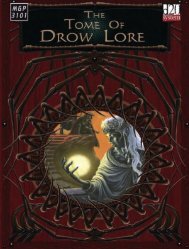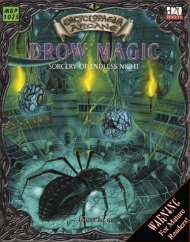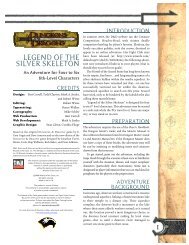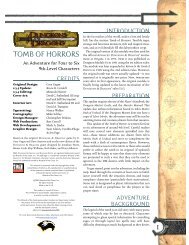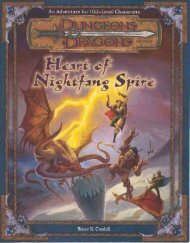The Drow War Book Two. The Dying Of - RoseRed
The Drow War Book Two. The Dying Of - RoseRed
The Drow War Book Two. The Dying Of - RoseRed
You also want an ePaper? Increase the reach of your titles
YUMPU automatically turns print PDFs into web optimized ePapers that Google loves.
76<br />
3. Desalinator Coils<br />
<strong>The</strong> air in this area smells strangely acrid, like the<br />
aftermath of a lightning strike. <strong>The</strong>re is a gurgling all<br />
around you as water flows through a complicated array<br />
of pipes, spiralling round several tall metal cones in the<br />
room’s centre.<br />
This machinery uses alchemical filtration to remove the<br />
salt from seawater, making it usable on board ship for<br />
drinking and washing. Sabotaging these devices would<br />
cripple the Celebration in a far more drastic way than<br />
would shutting down the engine, as it would leave the<br />
crew without any drinkable water. Sabotaging the coils<br />
requires a Disable Device check (DC 25) or a total of<br />
60 points of damage dealt to them. <strong>The</strong> coils have a<br />
hardness of 8.<br />
4. Alchemy Workshop<br />
A workbench has been set up here, with dozens of<br />
carefully labelled jars stacked on shelves beside it. <strong>The</strong><br />
jars have labels like ‘sulphur granules’, ‘tincture of<br />
elastium’ and ‘ground draconic enamel extract’. On<br />
the bench is a metal bowl filled with brown crystals,<br />
like Demerara sugar.<br />
Anyone with any skill ranks in Craft (alchemy)<br />
recognises this immediately as an alchemical laboratory.<br />
Dunstan has been working on an alchemical means to<br />
dry out food, so that it can be kept longer. <strong>The</strong> brown<br />
crystals are his first steps toward success.<br />
5. Reducing Cauldrons<br />
In this part of the ship, fifteen-foot-high wooden vats<br />
have been installed. A noisome bubbling sound comes<br />
from them. You smell a strong reek of fish.<br />
<strong>The</strong> cauldrons are used to reduce whale parts into usable<br />
oil. <strong>The</strong> vats have a hardness of 5 and can sustain 30<br />
points of damage before breaking open. If any of the<br />
vats is ruptured, steaming whale oil gushes out and<br />
floods the area, making the floor slippery in an 80-footradius<br />
spread.<br />
6. Pump Controls<br />
A bank of levers has been built into the wall here, with<br />
the word PUMPS scrawled above them. Beside the<br />
levers is a diagram showing to which parts of the ship<br />
they correspond.<br />
<strong>The</strong>re are six levers in total. Pulling one of them starts<br />
the bilge pumps going in that part of the ship. This<br />
lowers the water level from five feet to two feet in that<br />
area.<br />
7. Fog Vents<br />
At this point on the deck a thrumming metal pipe, five<br />
feet across, leads out through the hull. This must be the<br />
source of the fog that shrouds the ship. <strong>The</strong>re is a hatch<br />
in the side of the pipe.<br />
<strong>The</strong> hatch is there so that blockages in the vents can be<br />
found and removed. Characters can attempt to enter the<br />
ship through the fog vents. <strong>The</strong> continuous blast of hot<br />
steam gives total concealment and deals 3d6 points of<br />
fire damage per round to any character exposed to it,<br />
with a Reflex saving throw (DC 20) for half damage.<br />
Immediately inside the vent is an iron grille, bolted in<br />
place, to prevent creatures from clambering into the<br />
works. Beyond the grille is the access hatch, which is<br />
locked from within. Beyond the hatch, the pipe narrows<br />
to two feet.<br />
8. Brig<br />
This part of the ship is unlike any other that you have<br />
seen. To the west is the head of an enormous catfish,<br />
whiskered and goggling, made of some greenish metal.<br />
It is as if a fish-shaped construct had rammed the ship<br />
here and forced its way through the hull. As you watch,<br />
the metal eyes swivel slightly and puffs of steam come<br />
from the nostrils. It is either alive or made to look that<br />
way!<br />
<strong>The</strong> quality of workmanship is astonishing; each scale<br />
of the fish head seems to have been manufactured<br />
separately. A character who examines the fish’s<br />
mouth and succeeds at a Knowledge (architecture<br />
and engineering) check (DC 20) or Search check (DC<br />
25) notices that the fish’s mouth is hinged and can<br />
be opened. A further Search check (DC 25) locates<br />
a steam pipe concealed among the detail of the fish’s<br />
scales, which is apparently the power source for the<br />
opening mechanism. This runs down into the floor and<br />
eventually connects with the boiler. A character can<br />
sabotage Gugglehatch’s breath weapon by tampering<br />
with this pipe. A Disable Device check (DC 25) or a<br />
total of 40 points of damage dealt to the pipe (Hardness<br />
10) will render the breath weapon unusable.<br />
In fact, the brig is a sentient prison and has the name<br />
of Gugglehatch. Instead of locks and keys, whoever<br />
created the Celebration decided to make the prison<br />
and the guard the same thing. Locks can be picked,<br />
traps can be disarmed and guards can be killed, but a<br />
mechanical fish head is harder to bypass.<br />
Gugglehatch can only do three things: open and close<br />
its mouth (including making attacks), use its breath<br />
weapon and communicate. It speaks in a slow monotone,<br />
Ibon Presno Gonzalez (order #73006) 8






